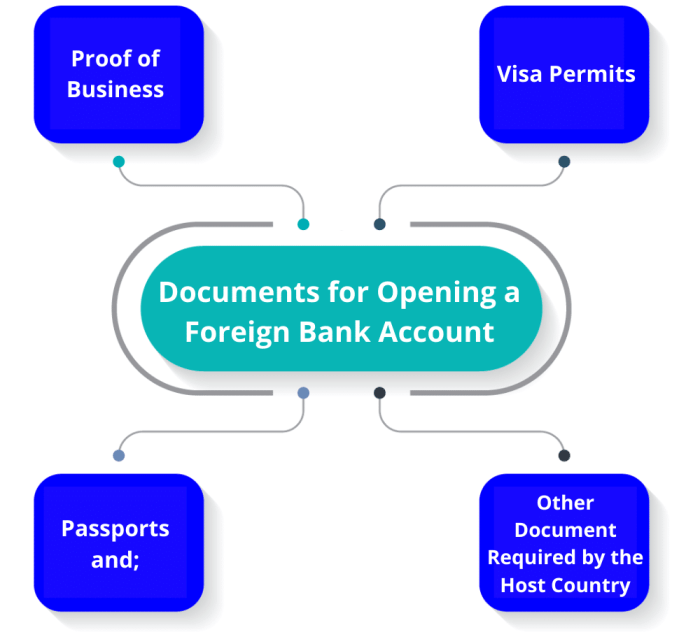What Is A Foreign Bank Account? This question opens the door to a world of international finance, offering both exciting opportunities and potential complexities. Understanding the nuances of foreign bank accounts—from their various types and benefits to the legal and tax implications—is crucial for anyone considering managing assets across borders. This comprehensive guide navigates the intricacies of foreign banking, providing a clear understanding of the process, risks, and rewards involved.
This exploration delves into the different types of foreign bank accounts available, outlining the steps involved in opening an account, and addressing the essential legal and tax considerations. We’ll examine the security measures in place, discuss risk mitigation strategies, and explore practical use cases, including international transactions and retirement planning. Ultimately, this guide aims to empower you with the knowledge needed to make informed decisions about managing your finances internationally.
Choosing the Right Bank and Jurisdiction: What Is A Foreign Bank Account

Selecting the appropriate foreign bank and jurisdiction for your account requires careful consideration of several key factors. The right choice depends heavily on your individual financial goals, risk tolerance, and the specific services you require. A poorly chosen bank or jurisdiction can lead to complications ranging from high fees to regulatory hurdles.Choosing a foreign bank involves navigating a complex landscape of varying regulations, fees, and services.
Understanding the nuances of different banking systems is crucial for making an informed decision that aligns with your financial objectives. This decision should not be taken lightly, as it carries significant implications for the security and accessibility of your funds.
Bank Reputation and Financial Stability
A reputable bank with a long history of stability is paramount. Consider the bank’s financial strength ratings from agencies like Moody’s, Standard & Poor’s, and Fitch. Look for banks with strong capital adequacy ratios and a history of sound financial management. Online reviews and independent financial news sources can also provide valuable insights into a bank’s reputation and customer service.
Avoid banks with a history of scandals or regulatory issues. For example, a bank with a history of money laundering accusations would be a high-risk choice.
Fees and Associated Costs, What Is A Foreign Bank Account
Foreign banks often charge various fees, including account maintenance fees, transaction fees, wire transfer fees, and currency exchange fees. Thoroughly research and compare the fee structures of different banks to identify the most cost-effective option. Hidden fees are common, so it’s crucial to review the bank’s fee schedule carefully before opening an account. For instance, some banks may charge significantly higher fees for international wire transfers compared to others.
Services Offered
Consider the services offered by the bank, such as online banking, mobile banking, ATM access, and customer support. Ensure the bank provides the services you need, such as international wire transfers, foreign currency exchange, and investment options. The availability of multilingual customer support can also be a significant factor, especially if you are not fluent in the language of the country where the bank is located.
For example, a bank offering robust online banking capabilities would be preferable for individuals who frequently manage their accounts remotely.
Banking Systems and Regulations Across Countries
Different countries have varying banking systems and regulations. Some countries have stricter regulations regarding Know Your Customer (KYC) and Anti-Money Laundering (AML) compliance, while others have more relaxed regulations. The level of banking secrecy also varies considerably. For example, Switzerland is known for its strict banking secrecy laws, while other countries have greater transparency requirements. Understanding these differences is crucial for making an informed decision.
Research the specific regulations of the jurisdiction you are considering to ensure compliance with all applicable laws.
Due Diligence and Risk Assessment
Performing thorough due diligence is crucial before opening a foreign bank account. This involves researching the bank’s reputation, financial stability, and regulatory compliance. Assess the risks associated with banking in a particular jurisdiction, including political and economic risks. Consider factors such as the country’s political stability, its economic outlook, and the potential for currency fluctuations. For instance, investing in a bank located in a politically unstable country poses a higher risk than investing in a bank in a stable, developed nation.
Checklist of Questions Before Opening a Foreign Bank Account
Before opening a foreign bank account, it’s essential to ask yourself several key questions. A thorough evaluation will help you make an informed decision that minimizes potential risks and maximizes benefits.
- What are the bank’s financial stability ratings and history?
- What fees does the bank charge, and are there any hidden fees?
- What services does the bank offer, and do they meet my needs?
- What are the banking regulations and laws in the chosen jurisdiction?
- What are the risks associated with banking in this jurisdiction, including political and economic risks?
- What is the bank’s customer service like, and what languages do they support?
- What are the procedures for opening and closing the account?
- What are the options for accessing funds, such as ATMs and online banking?
- What are the bank’s policies on international wire transfers and currency exchange?
- What are the bank’s security measures to protect against fraud and theft?
Illustrative Examples

Understanding the practical applications of foreign bank accounts requires visualizing their functionality. The following examples illustrate the features and online interfaces of various account types, offering a clearer picture of what to expect. Note that these are representative examples and the specific features and visual design may vary depending on the bank and jurisdiction.
Foreign Bank Savings Account
A typical foreign bank savings account offers features similar to domestic accounts, but with potential advantages like higher interest rates or access to international financial markets. The online interface would typically display a clean and straightforward dashboard. Imagine a screen with a prominent display of the current account balance, followed by a breakdown of recent transactions, perhaps in a tabular format showing date, description, and amount.
Below this, there might be sections for managing account settings, such as changing the notification preferences or setting up recurring transfers. A prominent button for making deposits and withdrawals would be readily available. The overall color scheme would likely be calm and professional, emphasizing trust and security.
Foreign Bank Investment Account
Foreign bank investment accounts provide access to a wider range of investment options compared to domestic accounts. The online dashboard would be more complex, reflecting the greater variety of assets. Imagine a screen displaying a portfolio overview with charts visualizing the allocation of funds across different asset classes (stocks, bonds, mutual funds, etc.). The transaction history would show detailed information on each buy and sell order, including the date, asset, quantity, price, and fees.
The dashboard would also include sections for researching investment opportunities, accessing market data, and managing risk profiles. The visual representation might incorporate interactive charts and graphs to allow for easy analysis of investment performance. Real-time data feeds might be integrated, reflecting the dynamic nature of investment markets.
Foreign Bank Online Banking Portal
The online banking portal’s visual layout prioritizes security and user experience. Upon logging in, a multi-factor authentication prompt might appear, perhaps requiring a one-time password sent to a registered mobile device. The main dashboard would present a concise summary of all linked accounts, with quick access to account details, transaction history, and account management tools. A prominent section would highlight security features, possibly including details on encryption protocols and fraud prevention measures.
The navigation would be intuitive and user-friendly, with clear labels and a consistent design language. The color palette would again likely be professional and reassuring, contributing to a sense of security and confidence. Customer support contact information would be readily accessible, reinforcing the bank’s commitment to customer service.
Navigating the world of foreign bank accounts requires careful consideration of numerous factors. From understanding the various account types and their associated benefits to meticulously addressing legal and tax implications, a proactive and informed approach is essential. By weighing the potential advantages against the inherent risks, and by conducting thorough due diligence when selecting a bank and jurisdiction, individuals and businesses can leverage the opportunities presented by international banking while effectively mitigating potential challenges.
This guide serves as a foundational resource for those embarking on this journey, providing the knowledge necessary for making sound financial decisions in the global marketplace.

